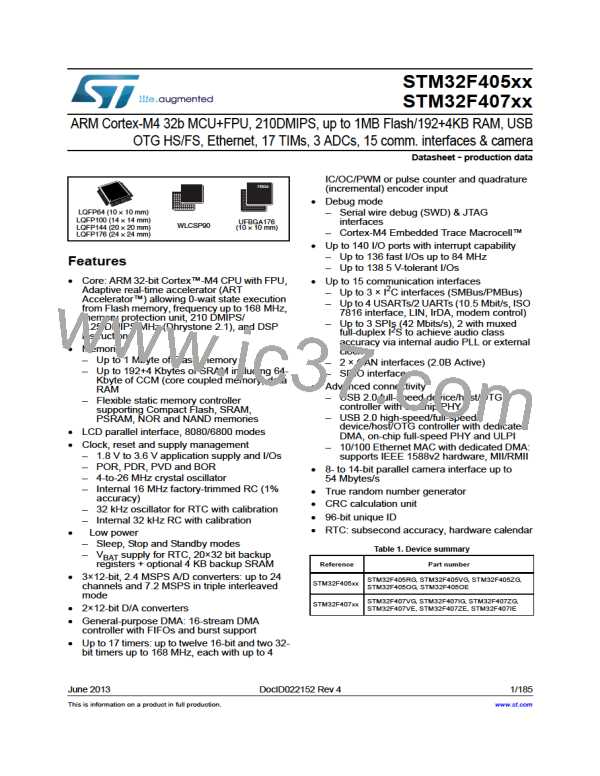STM32F405xx, STM32F407xx
Pinouts and pin description
Table 7. STM32F40x pin and ball definitions (continued)
Pin number
Pin name
Alternate functions
Additional functions
(function after
reset)(1)
TIM4_ETR / FSMC_NBL0
/ DCMI_D2/ EVENTOUT
-
-
-
-
97 141 A4 169
98 142 A3 170
PE0
PE1
I/O FT
FSMC_NBL1 / DCMI_D3/
EVENTOUT
I/O FT
S
63
-
-
99
-
-
D5
-
VSS
A8
143 C6 171
144 C5 172
PDR_ON
I
FT
10
0
64 A1
VDD
PI4
S
TIM8_BKIN / DCMI_D5/
EVENTOUT
-
-
-
-
-
-
-
-
D4 173
C4 174
I/O FT
I/O FT
TIM8_CH1 /
DCMI_VSYNC/
EVENTOUT
PI5
TIM8_CH2 / DCMI_D6/
EVENTOUT
-
-
-
-
-
-
-
-
C3 175
C2 176
PI6
PI7
I/O FT
I/O FT
TIM8_CH3 / DCMI_D7/
EVENTOUT
1. Function availability depends on the chosen device.
2. PC13, PC14, PC15 and PI8 are supplied through the power switch. Since the switch only sinks a limited amount of current
(3 mA), the use of GPIOs PC13 to PC15 and PI8 in output mode is limited:
- The speed should not exceed 2 MHz with a maximum load of 30 pF.
- These I/Os must not be used as a current source (e.g. to drive an LED).
3. Main function after the first backup domain power-up. Later on, it depends on the contents of the RTC registers even after
reset (because these registers are not reset by the main reset). For details on how to manage these I/Os, refer to the RTC
register description sections in the STM32F4xx reference manual, available from the STMicroelectronics website:
www.st.com.
4. FT = 5 V tolerant except when in analog mode or oscillator mode (for PC14, PC15, PH0 and PH1).
5. If the device is delivered in an UFBGA176 or WLCSP90 and the BYPASS_REG pin is set to VDD (Regulator off/internal reset
ON mode), then PA0 is used as an internal Reset (active low).
Table 8. FSMC pin definition
FSMC
WLCSP90
Pins(1)
LQFP100(2)
(2)
NOR/PSRAM/
SRAM
CF
NOR/PSRAM Mux NAND 16 bit
PE2
PE3
A23
A19
A23
A19
Yes
Yes
DocID022152 Rev 4
57/185

 STMICROELECTRONICS [ ST ]
STMICROELECTRONICS [ ST ]